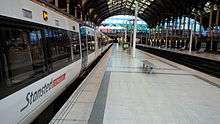London Stansted Airport
| London Stansted Airport | |||||||||||
|---|---|---|---|---|---|---|---|---|---|---|---|
 | |||||||||||
|
| |||||||||||
| IATA: STN – ICAO: EGSS | |||||||||||
| Summary | |||||||||||
| Airport type | Public | ||||||||||
| Owner | Manchester Airports Group | ||||||||||
| Operator | Stansted Airport Limited | ||||||||||
| Serves | London, United Kingdom | ||||||||||
| Location | Stansted Mountfitchet, Essex | ||||||||||
| Hub for | Ryanair | ||||||||||
| Elevation AMSL | 348 ft / 106 m | ||||||||||
| Coordinates | 51°53′06″N 000°14′06″E / 51.88500°N 0.23500°ECoordinates: 51°53′06″N 000°14′06″E / 51.88500°N 0.23500°E | ||||||||||
| Website | stanstedairport.com | ||||||||||
| Map | |||||||||||
 EGSS Location in Essex | |||||||||||
| Runways | |||||||||||
| |||||||||||
| Statistics (2015) | |||||||||||
| |||||||||||
London Stansted Airport (IATA: STN, ICAO: EGSS) is an international airport located at Stansted Mountfitchet in the local government district of Uttlesford in Essex, 30 mi (48 km) northeast of Central London and 0.9 mi (1.4 km) from the Hertfordshire border.
London Stansted currently serves over 170 destinations across Europe, North Africa, Central and North America and more scheduled European destinations than any other airport in the UK.[3] Stansted is a base for a number of major European low-cost carriers, being the largest base for low-cost airline Ryanair, with over 130 destinations served by the airline. In 2015 it was the fourth busiest airport in the United Kingdom after Heathrow, Gatwick and Manchester. Stansted's runway is also used by private companies such as the Harrods Aviation terminal which is opposite the main terminal building and handles private jets and some state visits.
The airport is owned and operated by the Manchester Airports Group (MAG), which also owns and operates three other UK airports. MAG agreed to buy the airport from Heathrow Airport Holdings, formerly BAA, on 18 January 2013,[4] and the sale was completed for £1.5 billion on 28 February 2013.[5] BAA had been required to sell the airport following a ruling originally made by the Competition Commission in March 2009.
Overview
London Stansted Airport has one main passenger terminal, near the village of Stansted Mountfitchet. There are three passenger satellites in which the departure gates are situated; one is connected to the main terminal by an air-bridge and the other two by the Stansted Airport Transit System people mover.
The terminal building was designed by Foster Associates with input from the structural engineer Peter Rice, and features a "floating" roof, supported by a space frame of inverted-pyramid roof trusses, creating the impression of a stylised swan in flight. The base of each truss structure is a "utility pillar", which provides indirect uplighting illumination and is the location for air-conditioning, water, telecommunications and electrical outlets. The layout of the airport was designed to provide an unobstructed flow for passengers to arrive at the short-stay car park, move through the check-in hall, go through security and on to the departure gates all on the same level.
From 1997 to 2007, Stansted saw rapid expansion of passenger numbers on the back of the boom in low cost air travel, peaking at 24 million passengers in the 12 months to October 2007, but passenger numbers declined in the next five years to 2012. Passenger totals have since risen, and in 2014 recorded an annual increase of 11.7% to 19.9 million.[2]
History
Second World War
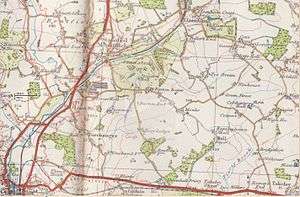

The airfield opened in 1943 and was used during the Second World War as RAF Stansted Mountfitchet by the Royal Air Force and the United States Army Air Forces as a bomber airfield and as a major maintenance depot. Although the official name was Stansted Mountfitchet, the base was known as simply Stansted in both written and spoken form.
The station was first allocated to the USAAF Eighth Air Force in August 1942 as a heavy bomber airfield. As well as an operational bomber base, Stansted was also a Air Technical Services Command (ATSC) maintenance and supply depot concerned with major overhauls and modification of B-26s. After D-Day, these activities were transferred to France, but the base was still used as a supply storage area for the support of aircraft on the continent.
Post-war use
After the withdrawal of the Americans on 12 August 1945, Stansted was taken over by the Air Ministry and used by No. 263 Maintenance Unit, RAF for storage purposes. In addition, between March 1946 and August 1947, Stansted was used for housing German prisoners of war.[6]
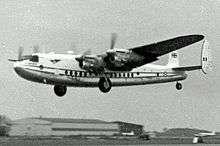
In November 1946, the recently established British cargo airline, London Aero and Motor Services (LAMS), equipped with ex-RAF Handley Page Halifaxes, moved into Stansted, using it as a base for its operations, until it was wound up in July 1948.[7]
The Ministry of Civil Aviation finally took control of Stansted in 1949 and the airport was then used as a base by several UK charter airlines. The US military returned in 1954 to extend the runway for a possible transfer to NATO. The transfer to NATO was never realised, however, and the airport continued in civil use, ending up under BAA control in 1966.
During the 1960s, 1970s and early 1980s the Fire Service Training School (FSTS) was based on the eastern side of the airfield under the auspices of the Ministry of Transport and Civil Aviation, now the Civil Aviation Authority. The school was responsible for the training of all aviation fire crews for British airfields as well as those of many overseas countries.
Commercial operations
Beginning in 1966, after Stansted was placed under BAA control, the airport was used by holiday charter operators wishing to escape the higher costs associated with operating from Heathrow and Gatwick.
In 1968–71 the Commission for the Third London Airport (the "Roskill Commission") did not include Stansted as one of its four short-listed sites and recommended that Cublington in Buckinghamshire should be developed as London's third airport.[8]
From the outset, however, BAA and the British government planned to develop Stansted into London's third airport, to relieve Heathrow and Gatwick of excess congestion in the future. The airport's first terminal building opened in 1969 and was expanded the next year to handle the growing number of passengers.
Since 1984 the airport's capacity had been limited to a maximum throughput of 25 million passengers per annum (25 mppa) in accordance with recommendations made by the 1984 public inquiry and confirmed by the government of the day.
In 1984, the government approved a plan to develop Stansted in two phases, involving both airfield and terminal improvements that would increase the airport's capacity to 15 million passengers per year. The current terminal building was designed by architect Norman Foster. Construction was undertaken by John Laing and took place between 1988 and March 1991,[9] costing £100 million.[10] In 1990 it was awarded the European Union Prize for Contemporary Architecture / Mies van der Rohe Award.
Long-haul scheduled services commenced in the early 1990s when American Airlines operated a transatlantic service between Stansted and Chicago, however the route was unprofitable and was withdrawn in 1993.[11] Continental Airlines also operated services in the late 1990s from Newark, but this service was stopped shortly after the 11 September 2001 attacks.
Long-haul services to the USA returned in late 2005, when Eos Airlines and MAXjet Airways commenced all-business-class services from Stansted to New York-JFK Airport. In 2006, MAXjet expanded their service with flights to Washington, D.C., Las Vegas and Los Angeles. American Airlines began daily flights to Stansted in October 2007 from New York-JFK and was originally expected to operate a second daily flight from April 2008. However, all three services to the USA have since been discontinued following the demise of MAXjet Airways in December 2007 and Eos Airlines in April 2008. Finally, in July 2008 American Airlines withdrew from the airport.
Latest developments
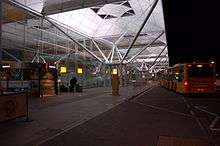
Long haul transatlantic operations made a return to Stansted in June 2010, when Sun Country Airlines announced a seasonal weekly service from Stansted to Minneapolis. The flights made a re-fuelling stop-over in Gander, Newfoundland and Labrador as the aircraft used for the flight, a Boeing 737-800, would not be able to complete a non-stop westbound flight from Stansted to Minneapolis. The flights operated from 11 June to 15 August 2010. In 2011, Sun Country operated to Gatwick rather than Stansted and were then discontinued due to the price involved in carrying fuel on long haul flights.
Stansted also had scheduled and charter flights to Toronto, Montreal and Vancouver, but these flights to Canada have now ceased. Long-haul services to Asia commenced in March 2009 with Malaysian low-cost airline AirAsia X providing direct flights to Kuala Lumpur; however, since 24 October 2011, these flights have operated from Gatwick Airport instead.
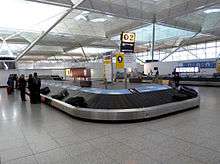
A major expansion programme to the existing terminal took place between 2007 and 2009, adding nearly 5,900 m2 (64,000 sq ft) of floorspace to give space for additional baggage carousels, a new immigration and passport control hall and a hypostyle arrivals hall with improved facilities.
In November 2006, Uttlesford District Council rejected a BAA planning application to increase the permitted number of aircraft movements and to remove the limit on passenger numbers. BAA immediately appealed against the decision and a public inquiry opened lasting from May until October 2007. Planning Inspector Alan Boyland made his recommendations in January 2008. Those recommendations were largely followed by the Secretary of State for Transport (Geoff Hoon) and the Secretary of State for Communities and Local Government (Hazel Blears), who jointly allowed the applicant's appeal in October 2008. A series of legal challenges by community campaign group Stop Stansted Expansion (SSE) were rejected by the High Court during 2009.
In 2008, 57 people were arrested after Plane Stupid, the environmental activist group, broke through the barriers and created a 'stockade' on a taxiway which resulted in 52 flights being cancelled.[12]
The Competition Commission ruled in March 2009 that BAA should sell Gatwick and Stansted Airports within two years.[13] The ruling was quashed within a year following an appeal but was subsequently upheld.[14] The Competition Commission reconfirmed its ruling in July 2011 that the airport be sold,[15] and the Court of Appeal turned down an appeal by BAA on 26 July 2012.[16] In light of the result, BAA chose not to appeal to the Supreme Court of the United Kingdom and confirmed on 20 August 2012 that the airport would be sold.[17]
Infrastructure
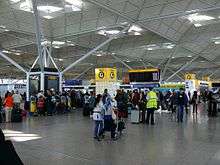
Terminal and Satellite buildings
Stansted is the newest passenger airport of all the main London airports. The terminal is an oblong glass building, and is separated into three areas: Check-in and main concourse along the front, Departures towards the back left and Arrivals on the back right upon entry. There are no gates in the main Terminal building; instead there are three separate oblong satellite buildings in which the gates are located. A fourth satellite building was planned, in addition to an extension to the main terminal building, but never completed.
An additional building, known as the Advanced Passenger Vehicle (APV), was brought back into use in 2016 for flights departing during the busy 06:00 to 08:00 period.[18] The APV building is linked to the main terminal building by an accessible route and acts as a bus terminal for international flights at remote stands. Prior to the completion of Satellite 3, this terminal (then numbered gates 90-95) was in regular passenger use.
| Satellite Building | Gate Numbers | Passenger Access | Notes |
|---|---|---|---|
| Satellite 1 | 1-19 | Transit system | Used by all airlines except Ryanair. Furthest in distance from main terminal but first stop on transit when departing main terminal |
| Satellite 2 | 20-39 | Transit system | Used exclusively by Ryanair. Closest in distance from main terminal but second stop on transit when departing main terminal |
| 81-88 | Walkway from main terminal building | Domestic arrivals mixed with domestic and international departures; special exit route for domestic arrivals | |
| Satellite 3 | 40-58 | Walkway from main terminal building | Used exclusively by Ryanair; no air bridges serving the gates. |
| APV | 90-93 | Walkway from main terminal building | Used only by Ryanair; acts as a terminal for buses to remote stands. |
Domestic arrivals use a separate exit route, located at the far left, when facing the main entrance. This exit is connected solely by footbridge to Satellite 2. When a domestic flight arrives at a gate which is not located in Satellite 2, passengers are transported to a gate on Satellite 2 by a courtesy bus service from the aircraft.
The terminal facilities include several bureaux de change, luggage services, internet access, toilets, showers, a chapel and multi-faith prayer room for worship.[19] There are over 60 shops, bars, restaurants and cafés throughout the airport as well as airport lounges.[20]
Car parks and hotels

Stansted has a variety of car parking including Long, Mid and Short Stay options along with Valet and Meet and Greet Parking services. There are also two drop off areas available. The express area is located near the short stay car park while a free service is within the mid stay. A fee is charged for the express service.[21] Terminal Road North and its free drop off area directly outside the terminal was closed shortly after MAG took over the airport in 2013. Since 2004, Stansted also offers a range of hotel accommodation including the Hilton, Premier Inn and Radisson Blu hotels, the last of which is within two minutes of the Terminal building via an undercover walkway. There are regular bus service transfers between the Terminal building and Stansted's car parks and hotels.
Control tower
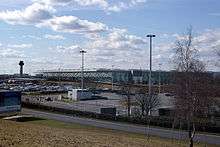
Stansted's air traffic control tower was completed in 1996 and is amongst the tallest in Britain and was the tallest at the time of its construction.[22] It is located at the north-east of the airfield just to the south of the terminal building. It has green-coloured tinted glass which matches that of the windows on the satellite buildings. It replaced the old control tower, which offered poor views of the airfield once the current terminal building was opened in 1991.
Other infrastructure
There are several cargo buildings and hangars around the airfield. The main cargo centre is located by the control tower and handles most cargo operations, including aircraft such as the McDonnell Douglas MD-11 and the Boeing 747. There are a small number of hangars on the other side of the runway to the rest of the airport. The largest are located at the south east of the airfield, one of which is used by Ryanair.
Titan Airways has its head office in the Enterprise House on the airport property.[23] Several airlines at one time had their head offices on the airport property. AirUK (later KLM uk) had its head office in the Stansted House.[24][25] When Buzz existed, its head office was in the Endeavour House.[26] When AB Airlines existed, its head office was in the Enterprise House.[27] For a period Lloyd International Airways had its head office at the Lloyd House at Stansted.[28] When Go Fly existed its head office was at the Enterprise House.[29]
Proposed developments
Abandoned plans for a second runway
On 11 March 2008, BAA submitted a planning application (titled "G2") to expand the airport by 3 sq mi (8 km2) and for the construction of a second runway and terminal, etc., in line with a recommendation in the 2003 Air Transport White Paper (ATWP). This would have been the subject of a public inquiry and, if approved, would have allowed Stansted to handle more passengers than Heathrow did at the time of the application.[30]
In May 2010 BAA withdrew its plans to build a second runway at Stansted and withdrew the plans to build a new runway at Heathrow.[31]
The ATWP had anticipated that a second runway would be operational by 2011, but this date continued to slip. BAA's 2008 planning application envisaged operation commencing in 2015, and in 2009, BAA revised the anticipated opening date to 2017.
Prior to the United Kingdom's May 2010 general election, all three major political parties pledged not to approve a second runway. Soon after the election, the new government confirmed this, and BAA withdrew its application for planning permission, having spent nearly £200 million preparing for the public inquiry and buying up properties.
The public inquiry into BAA's second runway application had been scheduled to start on 15 April 2009, but the start was delayed by Secretary of State Hazel Blears to allow time for BAA and the Government to consider the implications of the March 2009 Competition Commission's ruling that BAA must sell Stansted within two years. As 2011 drew to a close, BAA was still appealing against the Competition Commission ruling. On 20 August 2012, after losing a case at the Court of Appeal, BAA agreed to cease challenging the Competition Commission's ruling and to sell Stansted.
On 10 February 2010, Secretary of State John Denham, in an open letter, concluded that the inquiry could not reasonably start until after the General Election. In addition, he commented that the planning application documents were nearly two years old and would require updating. Eventually, BAA realised the futility of pursuing its G2 application in the context of the new government policy and withdrew it on 24 May 2010.[31]
Stop Stansted Expansion (SSE)
The advocacy group Stop Stansted Expansion ("SSE"), formed in 2002 as a working group of the North West Essex and East Herts Preservation Association, in response to the Government's consultation on expanding UK airports and, particularly, expansion plans for Stansted Airport subsequently defined in the Air Transport White Paper in December 2003.[32]
It still actively campaigns against what its members see as the unsustainable expansion of the airport. SSE was a major participant in the 2007 "G1" public inquiry and had committed to be a major participant in the anticipated inquiry into the 'G2' second runway proposal. Following the withdrawal of the G2 planning application the group called upon BAA to sell the homes it had bought to support the planned expansion.
In September 2012, as a result of pressure from the aviation industry, the Government set up the Airports Commission, chaired by Sir Howard Davies,[33] to consider what, if anything, needed to be done to maintain the UK's status as a global aviation hub. The Commission concluded that an additional runway would be required for South East England and that it should be added to either Heathrow or Gatwick. Following the 2015 election the Commission made a final recommendation to expand Heathrow subject to certain environmental constraints.
Throughout 2013 the Airports Commission published discussion papers and invited submissions from key stakeholders on the main issues it wished to consider. SSE made several thorough submissions. SSE also accepted an invitation to give oral evidence and make a presentation to the Commission on aviation demand forecasting and connectivity at a public evidence session held in Manchester in July 2013.[34]
Terminal redevelopment
MAG announced on 20 June 2013 as part of a visit to the airport by the Secretary of State for Transport that it would be launching an £80 million terminal redevelopment programme. MAG has invested £40 million and the remainder was invested by other commercial partners.The redevelopment included relocation of the security area, doubling the amount of seating and improving the information displays. The new Departure Lounge offers a Food Court, a number of new shops and Escape Lounge. However, many travellers have voiced concerns and complaints about the new layout because passengers are guided through a shopping walkway, and seating has been reduced in the main departure lounge.[35] Satellite One has also been redeveloped with the aim to attract more long haul airlines to Stansted.[36]
Airlines and destinations
Passenger
The following airlines operate regular scheduled and charter flights to and from Stansted:[37]
Cargo
Statistics
1988–2000
In 1988, over 1.1 million passengers passed through Stansted, the first time annual passenger numbers had exceeded 1 million at the airport.[48] Consistent year-on-year growth followed and by 1997 the total had reached over 5 million, rapidly rising to almost 12 million in 2000.[2]
2000 onwards
In 2007 passenger numbers peaked at nearly 24 million, but then declined for 5 years and in 2012 the total was around 17.5 million. An increase of 2.2% was recorded in 2013 to 17.8 million passengers, then 11.7% in 2014 to 19.9 million, followed by 12.8% in 2015 to 22.5nbsp;million, making Stansted the fourth busiest airport in the United Kingdom.[2] Stansted also is a major freight airport, the third busiest in the UK during 2015, behind London Heathrow and East Midlands Airport, handling in excess of 207,000 tonnes per annum, although freight throughput has declined slightly from its 2005 peak level.[2]
Passenger numbers for the year to September 2016 increased by 8.4% to over 24 million for the first time since 2007.[49]

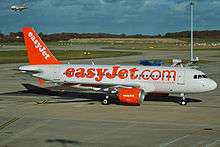
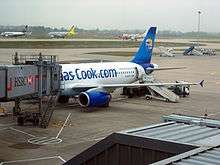
.jpg)
%2C_OO-TZC%40STN%2C21.11.2006-439bz_-_Flickr_-_Aero_Icarus.jpg)
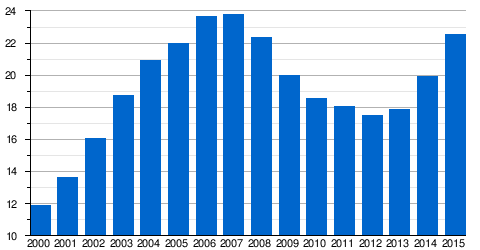 |
| Updated: 4 April 2016. |
| Number of Passengers[nb 1] | Percentage Change | Number of Movements[nb 2] | Freight (tonnes) | |
|---|---|---|---|---|
| 2000 | 11,878,190 | – | 165,779 | 167,823 |
| 2001 | 13,665,333 | | 169,583 | 165,660 |
| 2002 | 16,054,522 | | 170,544 | 184,449 |
| 2003 | 18,722,112 | | 186,475 | 198,565 |
| 2004 | 20,910,842 | | 192,245 | 225,772 |
| 2005 | 21,998,673 | | 193,511 | 237,045 |
| 2006 | 23,687,013 | | 206,693 | 224,312 |
| 2007 | 23,779,697 | | 208,462 | 203,747 |
| 2008 | 22,360,364 | | 193,282 | 197,738 |
| 2009 | 19,957,077 | | 167,817 | 182,810 |
| 2010 | 18,573,592 | | 155,140 | 202,238 |
| 2011 | 18,052,843 | | 148,317 | 202,593 |
| 2012 | 17,472,699 | | 143,511 | 214,160 |
| 2013 | 17,852,393 | | 146,324 | 211,952 |
| 2014 | 19,941,593 | | 157,117 | 204,725 |
| 2015 | 22,519,178 | | 168,629 | 207,996 |
| Source: UK Civil Aviation Authority[2] | ||||
Busiest routes
| Rank | Airport | Passengers handled | % Change 2014 / 15 |
|---|---|---|---|
| 1 | Dublin | 897,748 | |
| 2 | Edinburgh | 622,172 | |
| 3 | Glasgow | 533,327 | |
| 4 | Rome-Ciampino | 515,514 | |
| 5 | Bergamo | 495,005 | |
| 6 | Barcelona | 490,068 | |
| 7 | Madrid | 453,641 | |
| 8 | Cologne | 387,788 | |
| 9 | Warsaw-Modlin | 371,836 | |
| 10 | Lisbon | 369,518 | |
| 11 | Budapest | 368,605 | |
| 12 | Málaga | 356,909 | |
| 13 | Prague | 333,672 | |
| 14 | Pisa | 333,111 | |
| 15 | Berlin-Schönefeld | 331,488 | |
| 16 | Belfast-International | 323,659 | |
| 17 | Palma de Mallorca | 320,455 | |
| 18 | Cork | 320,140 | |
| 19 | Kraków | 307,139 | |
| 20 | Amsterdam | 300,571 |
Ground transport
Transit system
The Stansted Airport Transit System connects the terminal to the satellite buildings via a 2 mi (3 km) free automated people mover service which runs on dual concrete track. The system uses a mix of Adtranz C-100 and Bombardier Innovia APM 100 vehicles to carry passengers to departure gates. Unlike the similar Gatwick Airport transit, the Stansted transit is only accessible "airside" (i.e. only after passengers pass through security).
Trains
Stansted Airport railway station is situated in the terminal building directly below the main concourse.
Services to London are on the Stansted Express train to and from London Liverpool Street in Central London. This service operates every 15 minutes and the usual journey time is roughly 45 to 53 minutes. Liverpool Street is served by the Central, Circle, Hammersmith & City and the Metropolitan lines of the London Underground network, offering access throughout London. The Stansted Express also calls at Tottenham Hale, for the Underground's Victoria line and connections to various destinations in North London and the West End. Some Stansted Express services also call at Stansted Mountfitchet, Bishop's Stortford and/or Harlow Town en-route to London Liverpool Street.
CrossCountry operates services from the airport to Birmingham New Street, via Cambridge, Peterborough and Leicester, which run every 60 minutes. Abellio Greater Anglia operates local stopping services to Cambridge.
Buses and coaches
Scheduled express bus or coach services run to and from Stratford (45 minutes), Victoria Coach Station (75 minutes), Liverpool Street Station (55 minutes) and Golders Green (70 minutes) (all in London), costing about half the train fare but taking longer. The bus station is next to the terminal building. National Express runs scheduled but infrequent direct coach services to the airport from Oxford as service JL737, taking about three hours, and hourly services to and from Cambridge.
A few local bus services operate to the nearby communities of Bishops Stortford and Stansted Mountfitchet, most notably the 510/509/508 (Harlow to Stansted via Stansted Mountfitchet, Parsonage Lane and Takeley respectively), 308 (Bishops Stortford to Stansted) and the 700 Express (Stevenage to Stansted). Villagelink services 5 and 7 connect to many of the nearby villages. Journeys are free of charge within the vicinity of the airport, by reason of a green travel plan instituted by the BAA to reduce staff demands for parking space.
Stansted is also the start of coach X30 service to Southend-on-Sea via Chelmsford and Southend Airport, oprated by First Essex, this route runs hourly 24 hours a day.
Roads
Stansted is connected to northeast London and Cambridge by the M11 motorway and to Braintree, Colchester and Harwich by the A120, which is dual-carriageway until Braintree. The road distance to London is 37 miles (60 km).
As of October 1996, the airport has 2,500 short stay parking spaces within walking distance to the terminal. In addition, as of the same month, the airport has over 8,000 long stay spaces located near the M11 motorway and A120 junction. A courtesy bus service links the long stay spaces to the terminal.[50] The airport also offers mid stay parking, closer to the terminal than its long stay spaces.[50] Stansted Airport also offers valet-parking and a meet and greet service which is similar to valet but marketed more at the leisure traveller market, both are run from the short stay car park[51]
Incidents and accidents
Stansted has been designated by the UK Government as its preferred airport for any hijacked planes requesting to land in the UK. This is because its design allows a hijacked airliner to be isolated well away from any terminal buildings or runways, allowing the airport to continue to operate while negotiations are carried out, or even while an assault or rescue mission is undertaken. For this reason Stansted has been involved in more hijack incidents than might be expected for an airport of its size.
- On 27 February 1982 an Air Tanzania Boeing 737-2R8C landed at the airport after having been hijacked on an internal flight from Mwanza to Dar Es Salaam and flown to the UK via Nairobi, Jeddah and Athens, where two passengers had been released. The hijackers demanded to speak to exiled Tanzanian opposition politician Oscar Kambona. This request was granted and after 26 hours on the ground the hijackers surrendered and the passengers were released.[52][53]
- On 22 December 1999, Korean Air Cargo Flight 8509, a Boeing 747-200F, crashed shortly after take off from the airfield due to pilot error. The only people on board at the time were the aircrew and all four were killed. The aircraft crashed in Hatfield Forest near the village of Great Hallingbury.
- On 6 February 2000, an Ariana Afghan Airlines Boeing 727 with 156 people on board was hijacked and flown - stopping at Tashkent, Kazakhstan and Moscow - to Stansted Airport. After a four-day stand-off the hostages on board were safely freed and the incident ended peacefully. It later emerged that the motive behind the hijack was to gain asylum in the UK, sparking debate about immigration into the country. A large number of passengers on board the plane also applied for asylum. The remainder returned to Afghanistan.[54] Nine hijackers were jailed but their convictions for hijacking were quashed for misdirection of the jury in 2003, and in July 2004, it was ruled that they could not be deported from the UK.[55]
- On 24 May 2013, Pakistan International Airlines flight 709 from Lahore, Pakistan was escorted by RAF Typhoons after being diverted from Manchester Airport due to an onboard threat. Two men were charged with endangering an aircraft.[56]
- On 21 September 2013, SriLankan Airlines flight UL503 inbound to Heathrow, was escorted by RAF Typhoons to Stansted Airport after being diverted. Two men were detained for endangering an aircraft, one was formally arrested.[57]
See also
- List of airports in the United Kingdom and the British Crown Dependencies
- List of Royal Air Force stations
References
Citations
- ↑ "London Stansted – EGSS". Nats-uk.ead-it.com. Retrieved 6 September 2013.
- 1 2 3 4 5 6 7 8 "Aircraft and passenger traffic data from UK airports". UK Civil Aviation Authority. 25 March 2016. Retrieved 4 April 2016.
- ↑ Based on IATA schedules for August 2016
- ↑ "Stansted Airport being sold to Manchester for £1.5bn". BBC News. 19 January 2013. Retrieved 28 February 2013.
- ↑ Sinead Holland (28 February 2013). "£1.5 billion Stansted Airport sale complete". Harlow Star. Retrieved 28 February 2013.
- ↑ Wright Aircraft Illustrated February 1978, p. 70.
- ↑ Wright Aircraft Illustrated February 1978, pp. 70–71.
- ↑ Roskill (1971). Report, Commission on the Third London Airport. London: HMSO.
- ↑ Ritchie, p. 173
- ↑ Above Us The Skies: The Story Of BAA – 1991 (Michael Donne – BAA plc), p. 62-63
- ↑ Harrison, Michael (1 April 1993). "American Airlines to quit Stansted: Long haul carrier scraps Chicago service". The Independent. UK. Retrieved 11 May 2010.
- ↑ "Runway protest strands passengers". BBC News. 8 December 2008. Retrieved 11 May 2010.
- ↑ "BAA could challenge airport sale". BBC News. 19 March 2009. Retrieved 28 February 2013.
- ↑ "BAA sell-off back on track after court ruling". BBC News. 13 October 2010. Retrieved 28 February 2013.
- ↑ "BAA loses final Competition Commission sell-off ruling". BBC News. 19 July 2011. Retrieved 19 July 2011.
- ↑ "BAA loses latest appeal against Stansted sale". BBC News. 26 July 2012. Retrieved 28 February 2013.
- ↑ "Stansted Airport to be sold by BAA". BBC News. 20 August 2012. Retrieved 28 February 2013.
- ↑ "Airport Management Report" (PDF). Retrieved 10 September 2016.
- ↑ "Prayer Room". Retrieved 11 February 2014.
- ↑ "Stansted Airport Lounge". Retrieved 11 February 2014.
- ↑ "Pick Up and Drop Off". Retrieved 2 June 2015.
- ↑ "Stansted Airport Control Tower – MDA Consulting". Retrieved 29 October 2010.
- ↑ "Contact Us." Titan Airways. Retrieved 16 December 2011. "Titan Airways Ltd Enterprise House Stansted Airport Essex CM24 1RN"
- ↑ "Home-page." [sic] AirUK. Retrieved 28 February 2010.
- ↑ "World Airline Directory." Flight International. 18–24 March 1998. 82.
- ↑ "Contact Us." Buzz. Retrieved 2 September 2009.
- ↑ "An Introduction to AB Airlines." AB Airlines. 30 January 1998. Retrieved 7 February 2011. "AB Airlines – Internet Enquiry Office Enterprise House, Stansted Airport Essex. CM24 1QW"
- ↑ "World Airline Directory." Flight International. 10 April 1969. 580. "Head Office: Lloyd House, First Avenue, Stansted Airport, Essex."
- ↑ "World Airline Directory." Flight International. 27 March – 2 April 2001. 77. "Enterprise House, 2nd Floor, Stansted Airport, Stansted, Essex, CM241SB, UK"
- ↑ "£2.5bn Stansted Generation 2 planning bid submitted". Transport Briefing. 12 March 2008.
- 1 2 BBC News: Heathrow and Stansted runway plans scrapped by BAA, 24 May 2010. Visited 20 June 2011
- ↑ [ARCHIVED CONTENT] The Future of Air Transport – White Paper and the Civil Aviation Bill. Webarchive.nationalarchives.gov.uk. Retrieved 16 August 2013.
- ↑ Airports Commission. GOV.UK. Retrieved 16 August 2013.
- ↑ Stansted Airport Airfield Fire Services 30 March 1998 Emerald Airways HS748 engine exploded on take off whilst carrying the Leeds United football team, aircraft written off but no one injured. Captain John Hackett received awards for his actions saving the passengers lives.
- ↑ http://www.airlinequality.com/airport-reviews/london-stansted-airport/
- ↑ "Transport Secretary Launches £80 Million Terminal Redevelopment". London Stansted Airport. 20 June 2013. Retrieved 11 February 2014.
- ↑ stanstedairport.com - Flight Information retrieved 9 September 2016
- ↑ "Cambridge News - News, Sport and Events from around Cambridge".
- 1 2 http://www.loganair.co.uk/loganair/press-office/256/scotland%26%23039%3bs-airline-spreads-its-wings
- ↑ "Flight Timetables - Jet2.com".
- ↑ "City of Derry Airport: Ryanair flight to London axed". 13 September 2016 – via www.bbc.co.uk.
- ↑ "Ryanair Launches London Summer 2017 Schedule, 2 New Routes To Strasbourg & Faro, Calls On Govt To Approve 3 London Runways In Post Brexit Initiative".
- ↑ "Offizielle Ryanair-Website - Billigflüge - Günstige Flüge".
- ↑ http://www.thomson.co.uk/flight/timetable
- ↑ "Thomson adds Stansted – Geneva service in W16". routesonline.com.
- 1 2 "Stansted: Freight carrier Cargolux launches Hong Kong and Luxembourg link". Eadt.co.uk. 10 February 2013. Retrieved 6 March 2013.
- ↑ UBM Aviation,OAG Cargo. "Welcome to Inforwarding – Operational Announcements for the Air Cargo industry". Retrieved 2 June 2015.
- ↑ "1983 – 1997 Airport Statistics – Aviation Intelligence". United Kingdom Civil Aviation Authority. Retrieved 28 January 2013.
- ↑ "London Stansted Airport". Airliner World (December 2016): 9.
- 1 2 Stansted Website on Stansted Parking Facilities, visited 19 June 2011
- ↑ Stansted Airport Press Release visited 21 June 2013
- ↑ "Stansted's Hijack History". BBC News. 7 February 2000. Retrieved 6 January 2014.
- ↑ "Hijacking Description". Aviation Safety Network. 6 January 2014. Retrieved 6 January 2014.
- ↑ "Special report: Hijack at Stansted". BBC News. 14 February 2000. Retrieved 5 April 2007.
- ↑ "Afghans win right to stay in UK". BBC News. 13 July 2004. Retrieved 5 April 2007.
- ↑ http://www.bbc.co.uk/news/uk-22658979 | Retrieved 24 May 2013
- ↑ "Two men arrested for 'endangering aircraft' as passenger plane is diverted to Stansted Airport". Herts and Essex Observer (Online). 22 September 2013. Retrieved 8 October 2013.
Bibliography
- Freeman, Roger A. (1994) UK Airfields of the Ninth: Then and Now. After the Battle ISBN 0-900913-80-0
- Maurer, Maurer (1983). Air Force Combat Units Of World War II. Maxwell AFB, Alabama: Office of Air Force History. ISBN 0-89201-092-4.#
- USAAS-USAAC-USAAF-USAF Aircraft Serial Numbers—1908 to present
- The Bishop's Stortford Herald newspaper, 26 April 2007.
- Ritchie, Berry (1997). The Good Builder: The John Laing Story. James & James.
- Wright, Alan J. (February 1978). "The Stansted Sage". Aircraft Illustrated. 11 (2): 69–75.
External links
![]() London Stansted Airport travel guide from Wikivoyage
London Stansted Airport travel guide from Wikivoyage
![]() Media related to London Stansted Airport at Wikimedia Commons
Media related to London Stansted Airport at Wikimedia Commons
